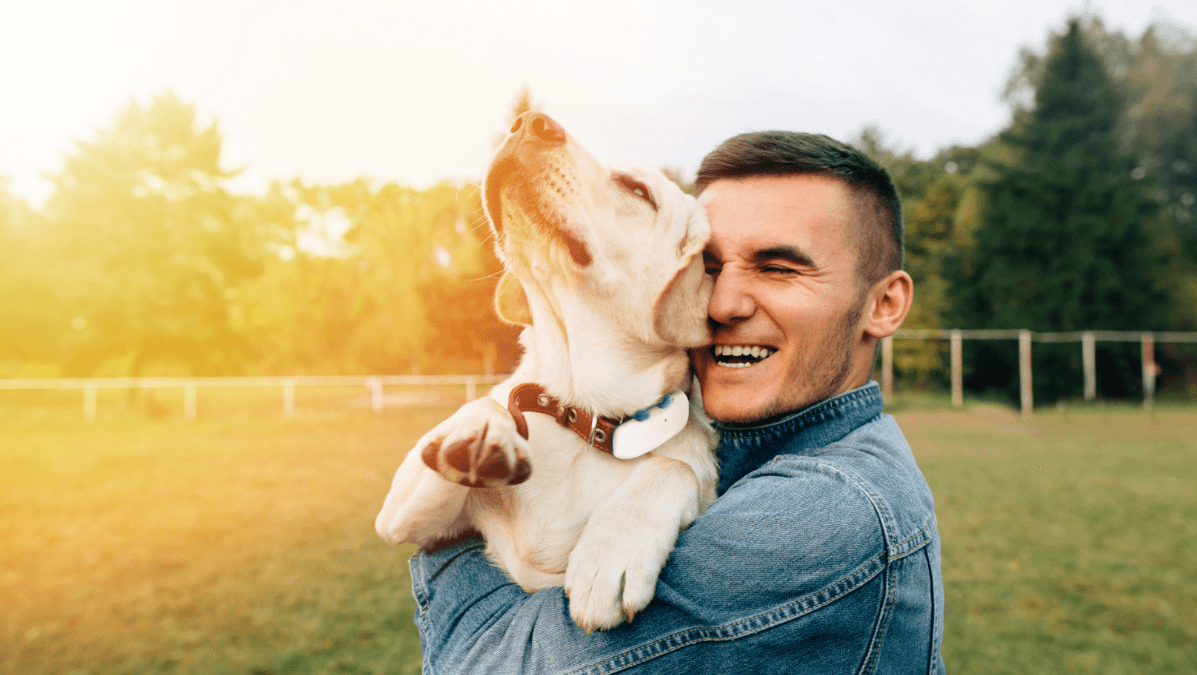The Ultimate Guide To Biking With Dogs
It might seem simple: just you, your dog, a bike, a leash and the open road. But you need a bit more preparation and practice before you start biking with your dog. Find out what you need to do to bike safely with your canine best friend in this post.
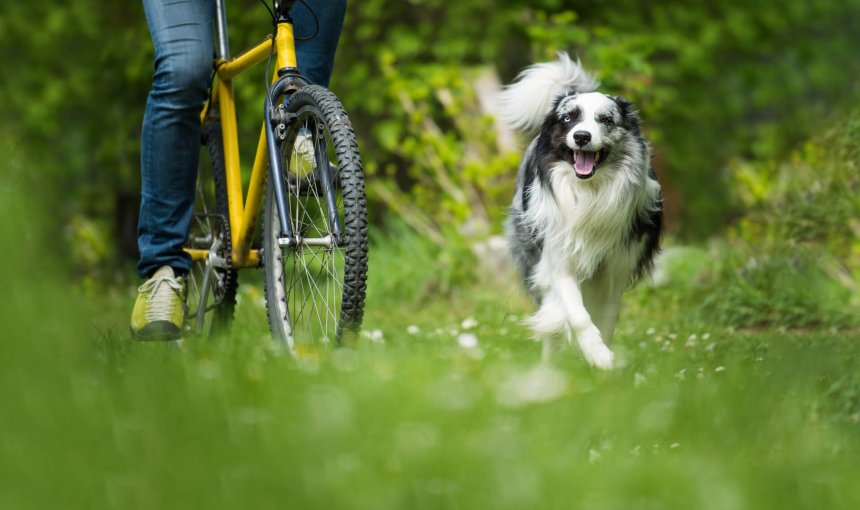
Warm weather is here, and you’re ready to break out your bike and hit the open road. What better way to enjoy some healthy exercise, the sun on your face and wind in your hair? But what about a furry companion – is it safe to bike with your dog? If so, what needs to be considered? And how much activity does your dog really need?
Whether you’re an expert cyclist or just starting to ride a bike; a new dog parent or a long time canine companion – we’ve got the ultimate guide to biking with dogs right here, so you can safely enjoy your outdoor adventures together.
Keep in mind: In some parts of the world (like Queensland, Australia), leading your dog while riding a bike is not legal. Be sure to follow local laws and guidelines to protect yourself, your dog, and others.
Why go biking with your dog?
First things first, why should you go biking with your dog? As every good dog mom or dad knows, our furry friends, just like us, need plenty of exercise and physical activity to stay healthy and in good shape. It’s our responsibility as dog parents to make sure we walk our dog enough each day. But why stop at walking? You may have plenty of other hobbies, like hiking, running or skiing. And just as you enjoy them, your dog can too!
- Running with Dogs: Best Practices You Need to Know
- Hiking With Dogs? Essential Tips For A Safe Adventure Together
Biking with your dog is a great way to stay fit together and strengthen the bond you have with your four-legged friend. Your dog will appreciate the fresh air and a chance to stretch their legs, and you’ll enjoy having a buddy to enjoy your favorite hobbies with!
So what needs to be considered when biking with a dog?
Tips for biking with dogs
Know your dog’s ability
Before you start biking your dog, it’s important to first make sure that your dog is physically fit enough to do so. Some dogs simply aren’t running dogs, so they’ll struggle to keep up with you on a bike. In these cases, biking with your dog can be cruel, so better leave your pal at home or only bring them along in a dog bike carrier, basket, backpack or trailer.
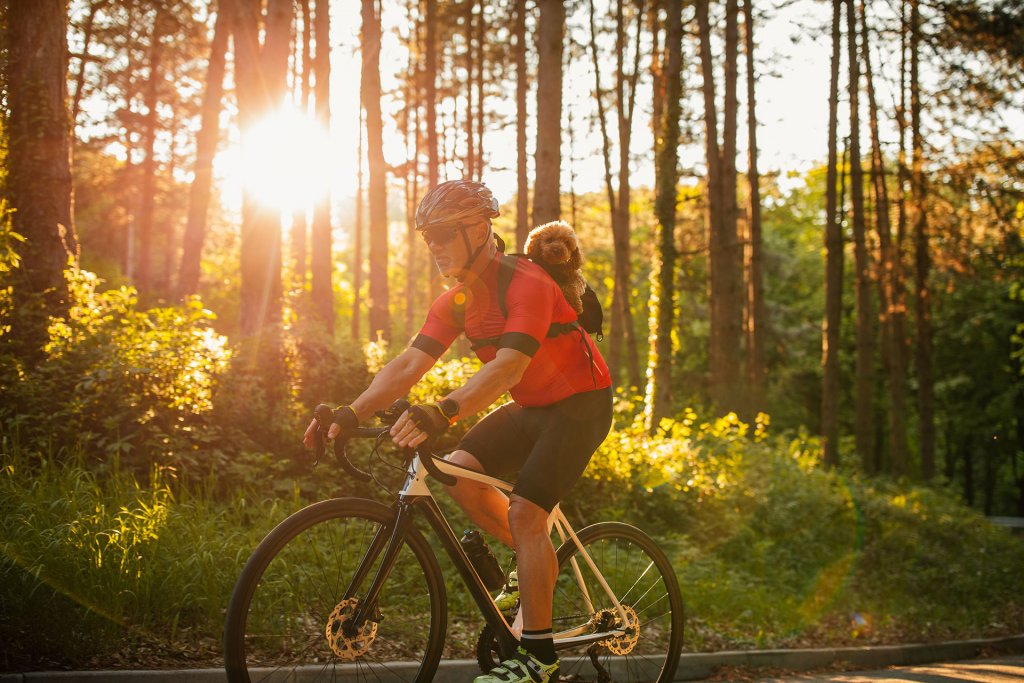
These types of dogs may have trouble running alongside your bike:
- Small, short dogs
- Large, heavy dogs
- Thick-coated dogs
- Old dogs
- Dogs with an illness or disease
- Overweight dogs
- Short-nosed dogs
If you are in doubt about your dog’s physical condition or abilities, ask your vet if they think it would be safe to bike with your dog.
Make sure your dog is trained and behaved
So now, maybe you think you’re ready to go out biking with your dog. Not so fast – an out of control puppy or dog that’s never had any behavioral training won’t make a good cycling buddy! The last thing you want is your dog bolting after a bird and ignoring your commands while you’re out riding a bike with them. Not only could you get hurt in a bike accident, but you could lose hold of the leash and your dog would be gone. So always make sure your dog is well-trained and behaved first, and knows how to walk nicely with you on the (loose) leash, before you attempt biking together. Your dog should show good behavior towards other people and animals, too.
The Guide To Leash Training A Puppy Or Dog
Get the right dog biking gear
Once you have the feeling that your dog is fit and mature enough to run on the leash beside you, it’s time to get the right dog biking gear. This includes:
- Bicycle dog leash: a leash that attaches to your bicycle, so your dog can run safely, away from the wheels of the bike
- Comfortable dog harness: when biking with your dog, always use a harness rather than attaching the leash to the collar. Choose a reflective harness to make your dog more visible or add reflective tape to your dog’s current harness.
- Lights: both for your dog and bike, lights are especially important if you could be biking at dusk or night.
- GPS dog tracker: to track your adventures together; but most importantly it will allow you to track and find your dog in real time in case they run away.
- Snacks, water and collapsible bowl: bring some healthy dog treats and water for both you and your dog to keep you fueled throughout your bike ride.
- Dog carrier: if you’re going on a longer trip, you may want to have the option to let your dog ride along in a carrier, trailer or basket in case they get tired. Better not wear out your furry friend!
- Optional: you might also want to take with you a normal dog leash for walking without the bike, dog boots, a warm jacket for your dog or rain gear.
Start out slow & take it easy
If you think your dog would make a good biking companion and you’ve got the right dog biking gear, then you’re ready to start your adventure together! But keep in mind: biking with your dog doesn’t just happen overnight.
If your dog has never been around a bike before, they might be scared, overly excited, or unsure what to do. So start off by slowly introducing your dog to the bike and then walking the bike along with your dog. This is an easy way to get your furry buddy used to the bike.
Then, start out easy by riding at a walking speed for a short distance. As your dog gets used to this, you can try biking a bit faster. Gradually increase the time you spend biking, and don’t expect your dog to be able to run for long distances in the beginning. Just like us, dogs need time to get used to a new exercise.
Always keep an eye on how your dog’s doing so that you can stop or adjust your pace according to their needs. It can take quite some time to get a dog used to being around a bike, but with patience and some positive reinforcement, it can be done!
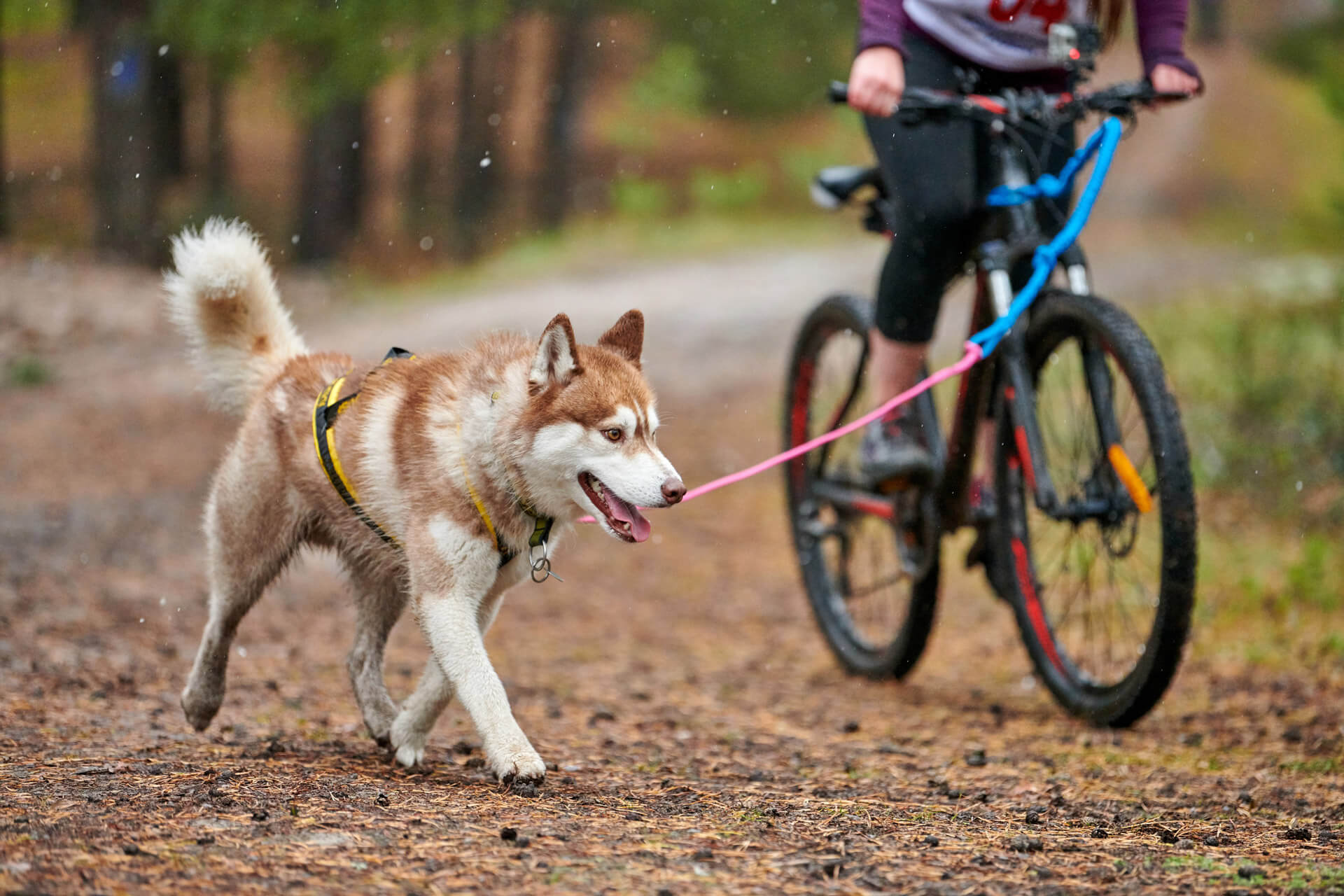
Take care of your dog’s paws
Beware of asphalt and rough terrain. While dogs’ paw pads are tougher than human feet, they too can be sensitive to rough terrain. Ideally, biking on grass or dirt trails is best, but this is not always possible. If biking on pavement is necessary, make sure you give the pads time to toughen up – step by step. If possible, mix up the terrain you bike on so that your dog is not constantly running on pavement. Dog boots can be a good idea. But each dog is different, and some dogs hate booties so much that you’ll never get them to keep them on. Finally, make sure to check their paws after a ride for cactus needles, stones or small cuts.
Be extra careful in warm weather
While biking, remember that warm weather can bring unique challenges for our four-legged friends. So you’ll need to take extra care. If it’s hot, there’s no shade, and on top of that your dog is running – they can easily get overheated. Extreme overheating can lead to heat stroke in dogs, a life-threatening illness. So you’ll want to:
- choose a dog friendly path, in the shade if possible
- avoid biking on days when it’s too hot outside
- provide plenty of fresh water
- go slow enough for your furry friend to run along comfortably and take plenty of breaks
- use sunscreen on your dog in case they will be exposed to the sun for a long time
Respect others
While biking with your dog, you also want to be mindful and respectful of others, and nature. Pick up after your dog, and follow the leave no trace rule. Keep your dog close or on a leash, and don’t let them bother other people or dogs. Not everybody likes dogs, no matter how friendly yours is, so keep a respectful distance to passersby.
Also, know that dog rules and laws can be different from one county to another. In some areas, biking with dogs is allowed and in other areas, it isn’t. In some countries biking with a dog is only allowed when the dog is on-leash. Before you take your pup for a bike ride, it is important that you inform yourself about the rules in your area.
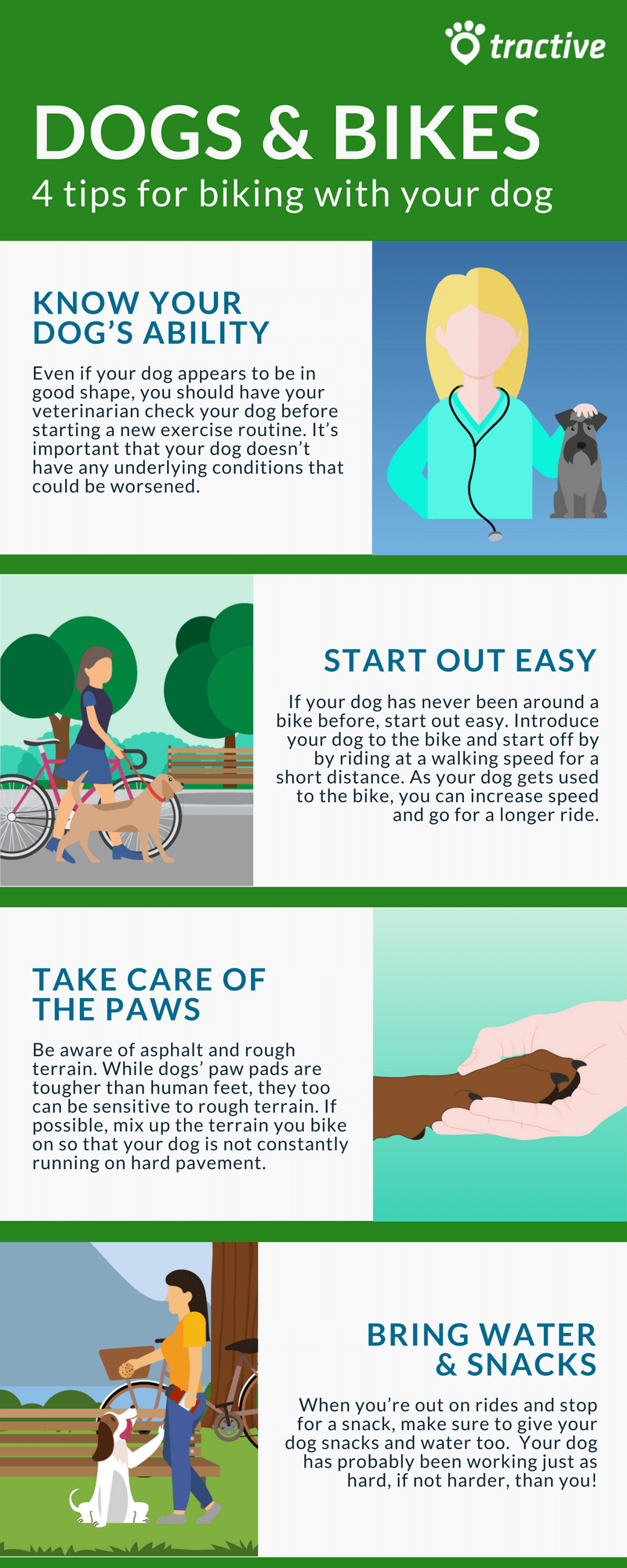
Conclusion: cycling with dogs
Even though we walk our four-legged friends several times daily, some dogs need more exercise than that. Healthy dogs need to run, and walking just isn’t enough exercise for them. Running with your dog is a great aerobic exercise, but many people can’t run or simply don’t like running. So why not bike with your dog? With the tips above, you’ll be ready to start your safe biking adventure together. And no matter what happens, a GPS dog tracker can help keep your dog safe and in sight. Fresh air, exercise and time spent together – it doesn’t get much better than that, does it?
Do you know another dog lover who’d love to go biking with their furry friend? Share this post with them!


